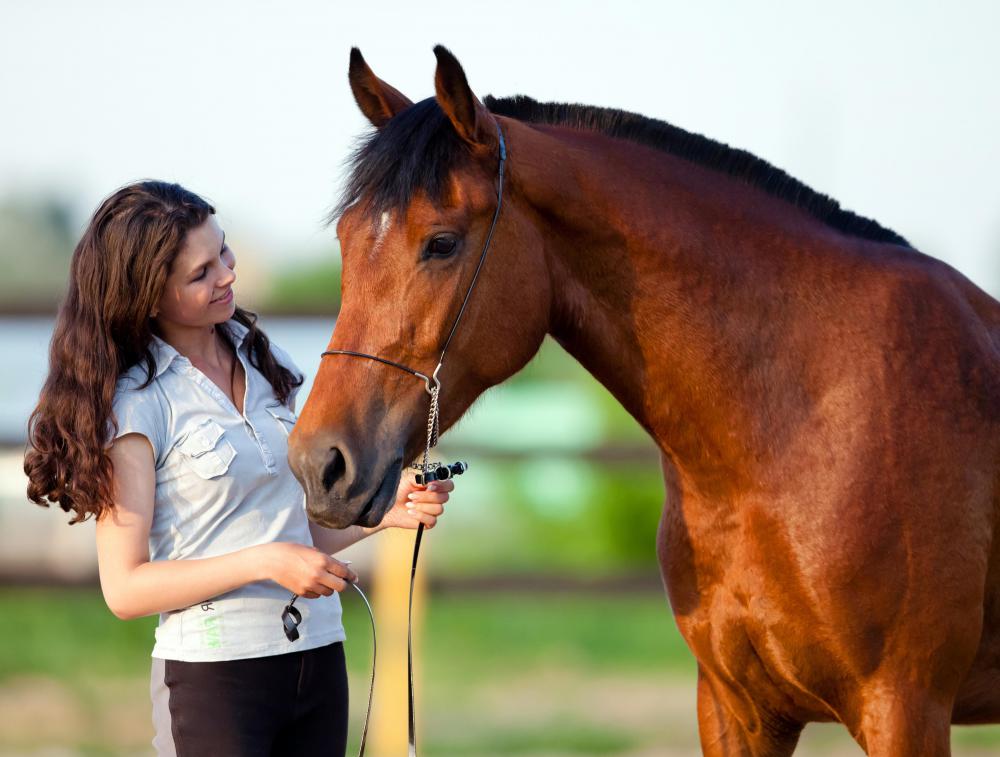What is Racking?
 Mary McMahon
Mary McMahon
Racking is a specialized horse gait in the family of “ambling” gaits, four beat gaits which fall between a walk and a gallop in speed. Ambling gaits are famously very smooth for riders, and also very energy efficient, and horses which demonstrate these beats are highly prized. A horse cannot be taught to rack; it must be born with the ability to perform the gait, although additional training can refine the rack.
Ambling gaits have been cultivated in horses for centuries. In the Middle Ages, these gaits were extremely popular, because people had to ride horses across great distances, and they wanted a gait which was comfortable and efficient. As other modes of transportation became available, racking and other lateral gaits grew less desirable, and today, horses that can demonstrate such gaits are known as “gaited horses,” reflecting the fact that they have a fifth gait in addition to the classic walk, trot, canter, and gallop.

In racking, both legs on one side are moved together, making it a lateral gait. Some horses can rack at a speed which approaches the canter, although it is also possible to see slower racks on display. This gait is known for being very showy, since horses must arch their necks and pull their forelegs up high to rack well. Some breeds, such as the American Saddlebred and Tennessee Walking Horse, are known for being big performers at the rack; Racking Horses and Paso Finos are also capable of moving at the rack.

For riders, the rack is a very comfortable gait. Many racking breeds are from the Americas, reflecting the fact that early colonists needed to be able to patrol large plots of land efficiently and comfortably, so they continued to breed racking horses after they largely disappeared in Europe. From the point of view of observers, riders often appear almost motionless in the saddle, illustrating the smoothness of the gait in contrast with the often choppy trot and canter.
Riders must learn some special skills to ride this gait well. While horses can demonstrate racking naturally if they belong to a racking breed, the gait can often benefit from being smoothed and controlled. Riders must learn to cue their horses to rack, and to control their horses while at this gait for the best effect. Many riders like to work with trainers when learning to ride gaited horses, to ensure that horse and rider do not pick up bad habits.
AS FEATURED ON:
AS FEATURED ON:












Discussion Comments
You couldn't give me a racking horse for free. I'll take a thoroughbred above all others. Experienced riders don't need a racking horse to cover ground quickly and efficiently when going cross country.
We spent one of our family vacations at a dude ranch one summer. No one in our family has had a lot of experience with horses, but we sure love to ride them.
The week we were at this ranch, my horse was a gaited Rocky Mountain horse. I knew enough about this breed of horse to know they are usually very gentle and even tempered.
I was so excited when I found out this was the horse I got to ride for the week. By the end of the week I was pretty attached to him. Even though I didn't know much about the different gaits, I could tell there was a difference between this horse and other horses I had ridden.
If I ever get lucky enough to live where I can have my own horses, I think buying a gaited horse would be what I would look at first.
One of my good friends works at a ranch for kids. Most of the horses they have there are donated from other people and they use them to teach the kids how to take take of horses. They also give lessons and trail rides quite often.
They had a beautiful Fox Trotter that had been given to them. This was a young, even tempered horse, that was a joy to ride. The only problem was that none of the other horses they had were gaited horses.
They eventually ended up selling him to a good home only because it was too hard to take him out on the trails with the other horses.
My friend and I would ride quite often, and before they sold him, this was always my first choice. It was especially fun to ride him in the arena when he got in to the rhythm of his gait.
If you are not used to riding a gaited horse, it can certainly take some getting used to. I had always ridden quarter horses and was used to a rough trot.
One of my friends had a Tennessee Walker that she let me ride on the trails. I was a little bit intimidated at first. Not only was this horse quite a bit taller than my quarter horse, but I had never ridden a horse with a gait before.
It didn't take me long to feel comfortable with it. I couldn't believe how much smoother the gait was, and how much more ground we covered on the trails in the same amount of time.
The horse didn't even seem winded or tired, but seemed to be the most content when he was going along at the gait he was comfortable with.
If I had tried to do this with my quarter horse, she would have been tired out, and I would have been tired and very sore! She isn't very comfortable to ride for long periods of time at that pace.
Post your comments